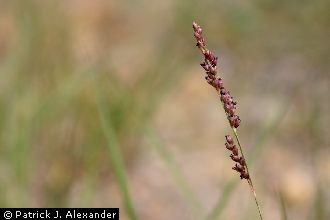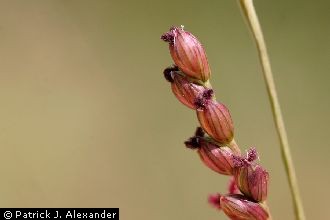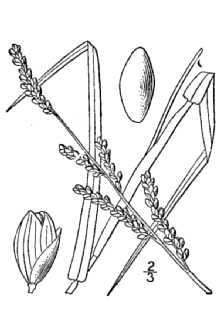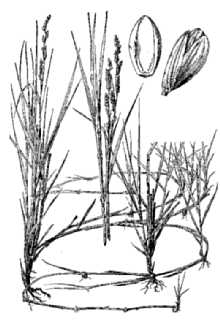Vine Mesquite
Scientific Name: Panicum obtusum Kunth
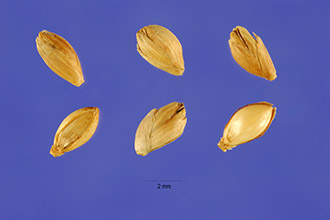
| General Information | |
|---|---|
| Usda Symbol | PAOB |
| Group | Monocot |
| Life Cycle | Perennial |
| Growth Habits | Graminoid |
| Native Locations | PAOB |
Plant Guide
Use soil moisture sensors to measure the soil moisture of Vine Mesquite.
Fact Sheet
Alternate Names
vine-mesquite, panic grass, vine mesquite grass
Uses
Grazing is the primary use of vine mesquite, but it has been cut for hay. It is used to control erosion in waterways and small gullies. Quail and doves eat the seed in the fall and early winter.
Status
Please consult the PLANTS Web site and your State Department of Natural Resources for this plant’s current status, such as, state noxious status, and wetland indicator values.
Description
Grass Family (Poaceae). Vine mesquite is a native, warm-season, stoloniferous perennial. The height ranges from 1-1/2 to 2-1/2 feet. The leaf blade is long; narrow, upright, and smooth. The leaf sheath is mostly basal and one-half to three-fourths as long as the internodes. The stolon is several feet long with long internodes, the nodes swollen and covered with hair. The seedhead has a narrow panicle 1 to 4 inches long with the spikelets large, nearly round, and brownish.
Management
From Britton & Brown (1913) @ plants.usda.gov This grass is seldom abundant enough to be a key management species. Generally, it is less palatable than most grasses associated with it therefore, it is seldom overgrazed. When used for hay or erosion control, grazing should be deferred until after seed production.
Establishment
Growth starts in April or May, It produces seedheads in July and August, The seeds are slow to disseminate, It reproduces from both stolons and seed, It is often associated with other grasses, but grows in more or less pure stands, It grows mostly in small depressions or along drainageways where water accumulates, Use soil moisture sensors to measure the soil moisture of Vine Mesquite., It grows best on sandy to sandy loam soils, but also grows on clay loams and gravelly loams, Cultivars, Improved and Selected Materials (and area of origin) Please contact your local NRCS Field Office,
Plant Traits
Growth Requirements
| Temperature, Minimum (°F) | -23 |
|---|---|
| Adapted to Coarse Textured Soils | Yes |
| Adapted to Fine Textured Soils | No |
| Adapted to Medium Textured Soils | Yes |
| Anaerobic Tolerance | High |
| CaCO3 Tolerance | Medium |
| Cold Stratification Required | No |
| Drought Tolerance | Low |
| Fertility Requirement | Medium |
| Fire Tolerance | High |
| Frost Free Days, Minimum | 150 |
| Hedge Tolerance | None |
| Moisture Use | High |
| pH, Maximum | 7.0 |
| pH, Minimum | 4.8 |
| Planting Density per Acre, Maxim | 19000 |
| Planting Density per Acre, Minim | 5000 |
| Precipitation, Maximum | 50 |
| Precipitation, Minimum | 8 |
| Root Depth, Minimum (inches) | 10 |
| Salinity Tolerance | None |
| Shade Tolerance | Intermediate |
Morphology/Physiology
| After Harvest Regrowth Rate | Moderate |
|---|---|
| Toxicity | None |
| Resprout Ability | No |
| Shape and Orientation | Erect |
| Active Growth Period | Summer |
| Bloat | None |
| C:N Ratio | Medium |
| Coppice Potential | No |
| Fall Conspicuous | No |
| Fire Resistant | No |
| Flower Color | Yellow |
| Flower Conspicuous | No |
| Foliage Color | Green |
| Foliage Porosity Summer | Moderate |
| Foliage Porosity Winter | Porous |
| Fruit/Seed Color | Brown |
| Nitrogen Fixation | None |
| Low Growing Grass | Yes |
| Lifespan | Long |
| Leaf Retention | No |
| Known Allelopath | No |
| Height, Mature (feet) | 2.0 |
| Growth Rate | Rapid |
| Growth Form | Rhizomatous |
| Fruit/Seed Conspicuous | No |
| Foliage Texture | Medium |
Reproduction
| Vegetative Spread Rate | Rapid |
|---|---|
| Small Grain | No |
| Seedling Vigor | Low |
| Seed Spread Rate | Slow |
| Fruit/Seed Period End | Fall |
| Seed per Pound | 145000 |
| Propagated by Tubers | No |
| Propagated by Sprigs | Yes |
| Propagated by Sod | No |
| Propagated by Seed | Yes |
| Propagated by Corm | No |
| Propagated by Container | No |
| Propagated by Bulb | No |
| Propagated by Bare Root | No |
| Fruit/Seed Persistence | No |
| Fruit/Seed Period Begin | Summer |
| Fruit/Seed Abundance | Low |
| Commercial Availability | Routinely Available |
| Bloom Period | Summer |
| Propagated by Cuttings | No |
Suitability/Use
| Veneer Product | No |
|---|---|
| Pulpwood Product | No |
| Protein Potential | Low |
| Post Product | No |
| Palatable Human | No |
| Palatable Graze Animal | Low |
| Palatable Browse Animal | Low |
| Nursery Stock Product | No |
| Naval Store Product | No |
| Lumber Product | No |
| Fodder Product | No |
| Christmas Tree Product | No |
| Berry/Nut/Seed Product | No |

